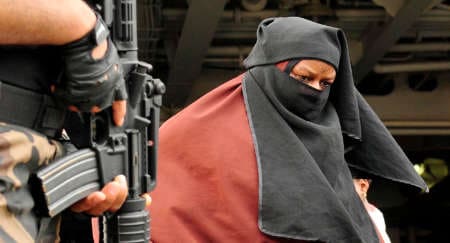The availability of small arms increases sexual violence against women. Therefore, gender based violence needs to be central to international discussions on the Arms Trade Treaty (ATT), and states must act to end impunity for armed violence against women.

When you call for help, people hear but they don’t come out to help when there are people with guns around © Reuter Jorge Silva
Marie was gang raped on 10 June 2010. “When you call for help, people hear but they don’t come out to help when there are people with guns around,” she says.
Her story is one of many others in Amnesty International’s January 2011 report on Haiti, entitled “Aftershocks: Women Speak Out About Sexual Violence”. Most of the rape victims interviewed were threatened by groups of men armed with guns.
Between February 28 and March 4 2011, states gathered in New York for the Arms Trade Treaty (ATT) Preparatory Committee. Discussions on the ATT present a vital opportunity to examine the tools used to commit acts of gender-based violence - most often small arms and light weapons (SALW). Although many binding international instruments exist on gender-based violence, these have not been taken into consideration by the disarmament community.
What impact do international transfers of conventional arms and ammunitions have on women’s lives?
Marie’s story reveals the invisible impact of armed violence: its impact on women’s minds, bodies and freedom. High death and injury rates of men are the most obvious and visible effects of gun violence. Yet what fails to appear in statistics is when guns are not used to kill but to exert power; when guns are used behind closed doors to subjugate family members; when guns are used to threaten adolescent girls with sexual violence, forcing entire families to flee. What we fail to talk about, when we talk about small arms, are the rapes of tens of thousands of women at gunpoint.
There is a strong correlation between carrying small arms and notions of masculinity, considered to be traditional “gun-culture”. Armed conflict can change men’s views about what qualifies as masculine behaviour: group pressure can amplify men’s aggressiveness and inclination to treat women as inferior. Since almost all men are armed in times of conflict, their weaponry can be implicated in the exercise of power over women.
In Colombia, where 60 to 70 percent of women have experienced some form of violence in their lives, the presence of guns in society is strongly linked to a patriarchal and “machista” culture, which supports the notion that men need guns to defend themselves and protect their families. Yet, instead of providing security, these guns aid and exacerbate violence against women and girls, both during and after conflicts.

Guns aid and exacerbate violence against women and girls, both during and after conflicts © Reuter Stringer Afghanistan Administration
During four days in the summer of 2010, a mass rape occurred in Luvungi, Eastern DRC (Democratic Republic of Congo). Nearly all of the 303 reported rapes were described as having been perpetrated by groups of two-to-six armed men, taking place in front of the women's children and husbands. It is estimated that 200 million small arms are in circulation in the Great Lakes region with a heavy concentration in the east of the DRC.
In Colombia, which has the second highest number of internally displaced people in the world after Sudan, 2 out 10 displaced women identify sexual violence as the direct cause of their displacement. In the armed conflict, all parties use sexual violence as a weapon of war.
In Sierra Leone’s civil war between 1991 and 2002, 64,000 women and girls suffered war-related sexual violence. Testimonies of women explain how the assaults were endured at gunpoint. ´They put their guns to our throats and stomachs to make sure that we followed their orders,’ one woman reported.
In Libya, rape is also being used as a tactic to instill fear. “They (...) forced him to watch as two of them took turns raping the woman,” recounted a Tripoli resident describing the invasion of a family member’s home by four armed militiamen.
The UN Security Council has recognised that rape in armed conflict is a threat to international security. So why are so many guns being sold to so many countries where rape is a strategy, a tactic to dehumanise and subjugate?
"For women, war is not over when it’s over."
It has been said that “for women, war is not over when it’s over.” According to a 2007 study from Montenegro, of 1500 women seeking assistance from women's shelters, 90 per cent were threatened with small arms by their partners. Often, guns brought home by off-duty soldiers, police and private security guards are used to facilitate domestic violence. In her recent visit to the US, the UN Special Rapporteur on Violence against Women noted the widespread use of guns in domestic violence.
By facilitating domination and violence against women, guns are used to prevent women from exercising their basic rights on a daily basis; in the marketplaces where they trade, in the fields where they work, at water-points and along the roads where girls walk to school.
From Haiti to the Balkans, the stories repeat themselves, endlessly. Guns are being used to take away women’s rights on a massive scale. So why is gender-based violence not part of the discussion on the arms trade?
In 2009, the US reversed its position on the ATT and decided to support negotiations. This policy shift by the world's largest arms exporter, with a $55 billion-a-year trade in conventional weapons (40 per cent of the global total), was a key step forward.
Meanwhile, the European Union recently made its internal code of conduct on arms exports legally binding in order to become a "very credible actor" as a promoter of the ATT. The 2012 negotiations will not be simple, but it is clear that to protect women’s rights, the relevant binding international instruments covering gender-based violence must be applied in arms transfer decisions.
Yet the ATT is not enough. States must also start collecting data. Without accurate data on gun possession and trafficking and their links to violence against women, it is impossible to formulate successful public policies on these issues.
Finally, states must take action to end impunity for armed violence against women and increase women’s participation in discussions on small arms policies.

